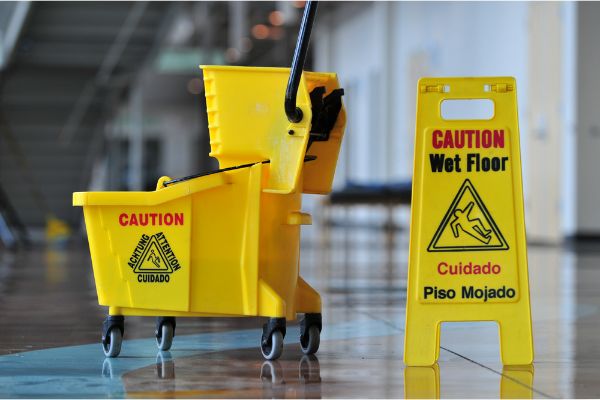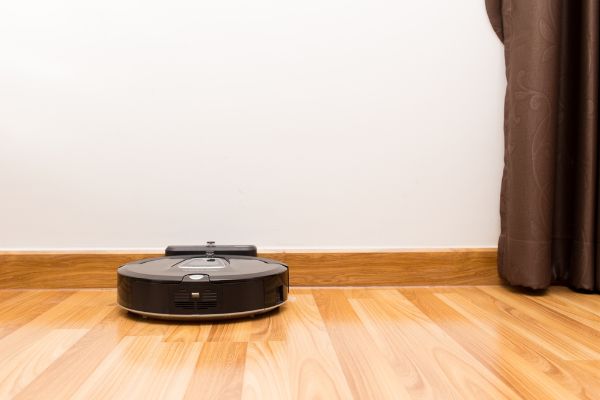Disclaimer: This post may contain affiliate links, meaning we get a small commission if you make a purchase through our links, at no cost to you. For more information, please visit our Disclaimer Page.
The Roomba is a popular automated vacuum cleaner from the iRobot company. Although it is specific to this brand, you may hear several kinds of robotic vacuums on the market referred to by this name.
iRobot has been making Roombas for many years, and different models have their own features or upgrades that are designed to be beneficial to homeowners. In general, they can be a great way to clean different rooms in your home on a schedule without having to trot out a standard vacuum cleaner and take the time to do it yourself.
As useful as these products can be, some users are concerned about water damage that they might incur during the cleaning process. We will go over whether a Roomba is even capable of handling a wet floor.
Additionally, we’ll discuss if the vacuums can avoid water or wet floors on their own, whether the iRobot company covers water damage to a Roomba, and what might happen if your robot vacuum does get wet. We can also go over what you might be able to do to fix it.
Table of Contents
Can a Roomba Go on a Wet Floor?
The answer to this question depends on what we might mean when we’re talking about a wet floor. If your Roomba goes over stops that are simply damp and do not feature standing water, it may be fine.
While there aren’t any guarantees here, it would not necessarily suck up water the same way it might if it went over a puddle. Standing water features far too much liquid that the vacuum is not designed to handle. For this reason, it is best to clean up any spills like this before your Roomba starts any of its cleaning cycles.
If you do find that the Roomba has gone over a damp rug or similar thing, you might find that some water has collected in its disposal bin and cleaning head modules.
In these situations, things should still be okay as long as you don’t use the Roomba long enough to let it dry out completely. Once it does, you should be able to return it to normal operations. It might be best to wait at least 24 hours.
This would help to ensure that everything inside the Roomba is dried enough to avoid any further damage once its schedule starts.
Will a Roomba Avoid Water?
Typically, there is no way for a Roomba to avoid water on its own. This is part of the design of most robotic vacuum cleaners. The camera of the Roomba faces out in order to help the device go from one zone to the next as it cleans. In other words, the camera is positioned to help the robot see where it needs to go, which is particularly helpful for avoiding obstructions.
However, this means that it can’t avoid going over things like water. Puddles, spills, and even some dropped debris wouldn’t count as obstructions to the Roomba, which is part of how the design is able to vacuum up things by itself.
Otherwise, it would simply avoid everything in its path. While it would be excellent to have your iRobot vacuum cleaner avoid water on its own, there are too many variables to consider to make this possible at the present time.
Does iRobot Cover a Water-Damaged Roomba?
Unless otherwise stated, iRobot does not cover water-damaged Roombas. There may be specific or mitigating circumstances in your own situation that might cause the company to consider repairing or replacing a vacuum with water damage on your behalf.
However, iRobot’s own warranty is a limited one that has exceptions as to what it will cover. Once you make a claim, the appropriate department at iRobot will determine how valid it is. If they choose to move forward, they will examine the damage to the Roomba to determine the best course of action.
For the most part, this limited warranty will cover any defects that are related to its manufacturing, or any problems that result in the robot behaving in a way that interferes with it doing its job effectively.
The limited warranty assumes that whatever defects are present are not the result of either normal wear and tear, misuse, or natural causes outside of anyone’s control. Because normal wear and tear is expected over the life of the product as you use it, iRobot may determine that this is what is happening to your vacuum cleaner.
Furthermore, any damage from things like lightning, water, fire, or general neglect will not be things that the company covers.
You can see the full document to get an even clearer understanding of just what is covered under the terms and conditions of the warranty. iRobot will also tell you how you can make a claim.
Additionally, you should be able to read more about your general rights as a consumer by visiting the company’s site. Should you have any questions as to possible exceptional cases that the warranty might cover for you, you can ask iRobot directly.
What Happens if My Roomba Gets Wet? 5 Symptoms & Fixes
Should your Roomba encounter some unexpected water, there might be a few things you can do for it. How salvageable it is might depend on just how much water it has taken on.
That said, it is possible that you can restore your robot vacuum cleaner to good working order without needing an official repair or replacement.
We will discuss the different symptoms you might encounter with your Roomba based on the water level it has in it, what these symptoms could mean, and possible fixes you might be able to perform yourself.
1. If your Roomba has trouble charging itself up, or if it cannot do so at all when it is plugged into its docking station, this could be a symptom of problems with water. In these cases, the bottom of the Roomba is wet, or it has absorbed some excess moisture that you cannot see.
There might be other issues at play, but not charging is one thing that water might do to the vacuum. Similarly, you may notice that the battery does charge but will not hold said charge for long.
You can try removing the battery completely and drying it with concentrated warm air. Once done, replace it to see if the robot will work again.
2. A lack of obstacle detection could also be a sign of water damage. The Roomba has sensors that allow it to see and go around barriers for effective cleaning.
Water can cause these parts to malfunction. It is harder to clean the sensors than the battery, but it might still be possible to open up the device and dry them out. Because sensors are delicate, there is no guarantee that you can restore them on your own, however.
3. Docking difficulties point to at least minor exposure to water. Going back to the dock is a relatively simple procedure for the robot, and any struggle with this means that some water damage is likely.
Again, opening up the device to dry it out completely is one of the best things you can try to do here.
4. No filtering or suction power could both be signs that the Roomba has taken on too much excess water. You can open up the bin to remove it and check for any water stored there. Additionally, you should be able to remove the filters and set them aside to dry completely.
5. If the Roomba won’t turn on at all, it could be a sign of serious water damage to several of the device’s internal systems. While there could be other culprits, it is one of the most difficult problems to assess.
If this issue keeps happening, it could be a sign that water damaged the motherboard inside the device. The motherboard is one of the most important components here, and your only solution may be to replace either the board or vacuum entirely.
How Can I Get Roomba To Avoid Water?
At present, there isn’t a good way to guarantee that your Roomba will avoid water. The best thing you can do is make sure there are no spills that it might go over before it starts its next cleaning cycle.
This is particularly true if you set any of the vacuum’s zones in locations that are prone to spills or excess moisture. For example, some basements are at a level where they might have issues with water seeping in, and it could be difficult to make sure that these areas are always free of water before the Roomba starts to clean them.
Conclusion
There is little doubt that robot vacuums like the Roomba are handy helpers around the house. Some companies may even use them in various office settings to get a little extra cleaning done overnight.
In either case, these computerized machines are mostly great at picking up small debris or messes while they avoid obstacles. However, water is no friend to the electronic components inside a Roomba. It is a good idea to check for any spills prior to letting the Roomba loose to help you with the rest of the cleaning.


